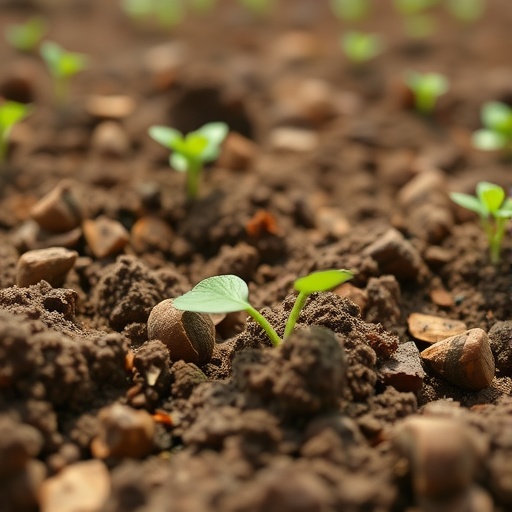In the heart of Jordan, the Zarqa River has long been a vital lifeline for agriculture and local ecosystems. However, rapid industrialization and urban development have posed significant threats to this essential waterway. A groundbreaking study led by Al-Qawasmeh and Ghrefat explores the complex interplay of pollution indices, spatial interpolation, and advanced machine learning techniques to analyze the soil contamination associated with this river. Their research offers not only critical insights into the levels of soil pollution but also paves the way for more effective remediation strategies.
Soil contamination is a pressing issue that can have dire consequences for human health, biodiversity, and agricultural productivity. Pollutants can enter the soil through various pathways, including industrial discharges, urban runoff, and agricultural practices. The Zarqa River, heavily influenced by these factors, has been targeted in this new research as it serves as an indicator of broader environmental health issues in the region. The study significantly contributes to existing knowledge on pollution dynamics and raises alarms on the urgent need for remedial action.
Employing pollution indices allows the researchers to provide a clear and quantifiable measure of contamination in soil samples collected along the Zarqa River. These indices serve as valuable tools for assessing the impact of specific pollutants based on environmental and health criteria. The study meticulously details various pollutants, focusing on their concentrations and effects, thus forming a robust foundation for further analysis. In doing so, the researchers highlight the importance of consistently monitoring these indices to steer environmental policy and public health initiatives.
Spatial interpolation techniques are another cornerstone of the study, allowing for the modeling of soil contamination across different geographic areas. These techniques provide insight into pollution patterns that may not be visible through localized sampling alone. By synthesizing collected data points, the researchers can create predictive maps showing potential contamination hotspots along the river. This spatial understanding is crucial for stakeholders in guiding resource allocation, regulatory measures, and public awareness campaigns targeting impacted communities.
One of the study’s most innovative aspects is its integration of machine learning methodologies into the analysis of soil contamination data. Machine learning algorithms are adept at identifying complex patterns within large datasets, enabling researchers to predict soil contamination levels with remarkable accuracy. This cutting-edge approach provides a powerful tool for environmental scientists, allowing for real-time monitoring and proactive strategies to mitigate soil pollution. Furthermore, these techniques can adapt and improve over time, refining predictions as new data becomes available.
The findings of this research have significant implications for public policy and environmental health in Jordan. As the impacts of soil and water pollution become increasingly evident, informed decision-making is critical. The study advocates for the implementation of stricter regulations on pollutants entering waterways and underscores the need for community engagement in pollution awareness. By fostering public dialogue around environmental issues, local governments can improve community resilience against the impacts of contamination.
Field studies like this one are not only essential for understanding the immediate risks of pollution but also serve a broader purpose in educating future generations about environmental stewardship. By highlighting the dire consequences of unchecked pollution, researchers can inspire proactive measures among students, policymakers, and local communities. Greater awareness can lead to enhanced responsibility, sparking initiatives that advocate for clean water and soil, ultimately benefiting both people and the planet.
The local agricultural industry, heavily reliant on the health of soil and water resources, stands to gain from the findings of this study. By identifying contaminated zones, farmers can make informed decisions regarding crop planting and soil management practices. Innovations in sustainable agriculture can be fostered as a reaction to this research, promoting food security while protecting natural resources. The coupling of agricultural practices with findings from studies like this could usher in an era of environmental accountability.
On an international scale, this research serves as a case study for other regions facing similar challenges related to soil and water contamination. Emerging economies undergoing rapid industrial growth can learn valuable lessons from the Zarqa River study. Different countries can adopt similar techniques to safeguard their natural resources while alleviating the ecological burden of pollution. This collaboration on shared concerns around environmental health may encourage global partnerships focused on sustainability.
In summary, Al-Qawasmeh and Ghrefat’s innovative integration of pollution indices, spatial interpolation, and machine learning provides a comprehensive framework for understanding soil contamination along the Zarqa River. Their findings advocate for proactive measures against pollution, with implications that reach far beyond Jordan’s borders. This research not only informs local policy and agricultural practices but also positions itself as a vital reference point for global environmental strategies related to soil health.
To realize the full benefits of this research, it will be crucial to implement the recommendations derived from the findings effectively. Local stakeholders, government agencies, and community organizations must collaborate to ensure that results translate into actions that enhance environmental health and protect public wellbeing. Engaging with local populations, building awareness, and fostering a sense of shared responsibility will be key to achieving lasting change.
In conclusion, the alarming reality of soil contamination along the Zarqa River calls for urgent attention and action. The intersection of industrial growth and environmental degradation is a challenge that many regions face today. Studies like this one serve as essential reminders of the need to safeguard our natural resources and take proactive measures in combating pollution. By harnessing the power of advanced methodologies and fostering community engagement, we can work towards a cleaner, healthier future for all.
Subject of Research: Soil Contamination Analysis along the Zarqa River, Jordan
Article Title: Integrating pollution indices, spatial interpolation, and machine learning for soil contamination analysis along the Zarqa River, Jordan.
Article References: Al-Qawasmeh, O., Ghrefat, H. Integrating pollution indices, spatial interpolation, and machine learning for soil contamination analysis along the Zarqa River, Jordan. Environ Monit Assess 197, 1137 (2025). https://doi.org/10.1007/s10661-025-14586-2
Image Credits: AI Generated
DOI:
Keywords: Soil contamination, Zarqa River, pollution indices, spatial interpolation, machine learning, environmental health, Jordan.




